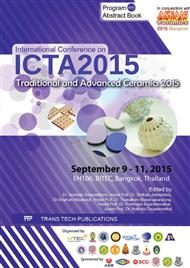p.236
p.240
p.246
p.252
p.259
p.264
p.268
p.272
p.276
Development of Decorative Ceramic Glaze from Palm Fiber Ash
Abstract:
Palm fiber ashes are the industrial waste which is abundantly available in Malaysia. In this study, palm fiber ash were used to produce decorative ceramic glaze. The content of minerals in the palm fiber ash were analyzed by using X-Ray Diffraction (XRD) and X-Ray Fluorescence (XRF), respectively. The formulations of glaze with different composition of raw materials were studied by adding different amount of calcium carbonate and feldspar. The glaze slurries then coated on ball clay body bisque which was obtained from Kg. Dengir and sintered at 1200 ° C for two hours.The glaze was characterized in term of its physical appearance such as type of glaze and colour. Both glossy and matte glaze produced by using different composition of glaze formulation. The presence of silica minerals (79 %) contributed to glossy surface to the glaze. It is clearly seen that the glossiness of glaze improved by increasing amount of feldspar. Feldspar acts as fluxing agent which form a glassy phase at lower temperature. In addition, the presence of small amount of iron oxide (2.2 wt.%) contributed to brown colour of glaze. An addition of calcium carbonate give effect to the colour of glaze, which change from brown to yellow colour as amount of CaCO3 increased. As a conclusion, the palm fibre ashes were highly suitable to supply abundant and cheap raw materials to produce decorative ceramic glaze.
Info:
Periodical:
Pages:
259-263
Citation:
Online since:
May 2016
Keywords:
Price:
Сopyright:
© 2016 Trans Tech Publications Ltd. All Rights Reserved
Share:
Citation:


